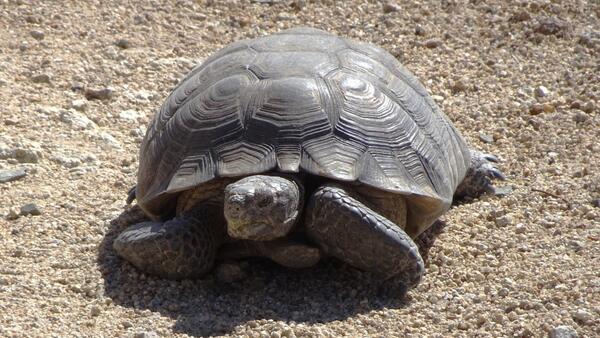Ecotones are where you can see change
Ecotone: a transitional area between two plant communities, such as forest and grassland. It has some of the characteristics of each bordering ecological community and often contains species not found elsewhere in the overlapping communities.
Ecotones, sharing species between different ecological communities, are areas with higher biodiversity than either community alone. Local examples include transition zones between forests and chaparral, between active sand dunes and stabilized sand fields, and between the Mojave and Colorado Deserts. Not only are these areas of high biodiversity they are also areas of environmental change, shifting boundaries resulting from shifting climates and ecological disturbances such as wildfire. As deserts become both hotter and more arid driven by modern climate change, the Colorado Desert encroaches on what was previously the realm of the otherwise cooler and wetter Mojave Desert. The ecotone shifts upslope and northward.
Signature species identifying the boundaries of the Mojave Desert include, Joshua trees, blackbrush (Coleogyne), California junipers, Mojave rabbitbrush (Ericameria), and Cooper’s box thorn (Lycium). For the Colorado Desert, signature species include desert fan palms, ocotillo (also in the Sonoran and Chihuahuan Deserts), desert agave, Bigelows’ nolina, and Baja desert thorn (Lycium). When you encounter these species, they give you a clear clue as to which desert you are in.
Joshua Tree National Park, by its namesake, would suggest that it is in the Mojave Desert. That would only be partially true; well over half of the park is in the Colorado Desert. One of the park’s trails that weaves along the current Mojave-Colorado Desert ecotone is the Lost Palms Oasis trail. Along the trail you will meet California Junipers, blackbrush, Cooper’s box thorn, and Mojave rabbitbrush, a.k.a. the Mojave Desert. However, mingled among these Mojave Desert plants is a healthy group of desert fan palms, along with Bigelow’s nolina, and Baja desert thorn – classic Colorado Desert plants growing side by side with those afore mentioned Mojave species. Also included are some species that seem to prefer this ecotone, such as the Chuckwalla cholla and Hall’s shrubby spurge, Tetracoccus hallii. Over the centuries and multiple ice ages during the Pleistocene there was a repeated ebb and flow of warmer and drier climates shifting to cooler and wetter climates, with the boundaries of what we now call the Mojave and Colorado Deserts shifting accordingly. The current ecotone is where suitable conditions for many of the Mojave and Colorado Desert species currently overlap, providing a refuge for a broad range of species. Some, like Joshua trees, western fence lizards, and Blainville’s horned lizards, are more sensitive to heat and aridity and abandoned this ecotone centuries ago.
This desert ecotone’s riches are not limited to plants. Along our Community Science Collaborative hike last week, we encountered healthy numbers of chuckwallas, desert spiny lizards, whiptails, and side-blotched lizards. We found a desert horned lizard, a species whose populations are increasingly shifting to the higher elevation regions of the Mojave Desert. Along with the lizards we came across a patch-nosed snake, a speckled rattlesnake, and a healthy desert tortoise. Butterflies were also abundant, desert queens, sleepy oranges, and dusky wings being most common.
Ecotones are where you can appreciate the rich biodiversity of the California deserts, but they are where you can see change as well. I have hiked the Lost Palms Oasis trail at least once a year for almost two decades. I remember that first hike 20 year ago, being impressed with the biodiversity I encountered, but also concerned that a few of the junipers appeared stressed, turning brown. I reached out to the park’s botanist at the time, Josh Hoines, who had noticed the same thing, but like me had no clue what was causing what appeared to be a disease impacting just the junipers. Over the next few years Josh, and then those who followed him, reached out to plant pathologists to understand what was happening, but with no success. The curious pattern was that sick junipers existed almost side by side with those that appeared completely healthy.
Over the years the sick junipers died, and more and more of the junipers were looking sick. Patterns of mortality started to emerge. Sick or stressed or dead junipers were concentrated on bajadas above the numerous dry, seasonal washes that dissected this terrain. Live, healthy junipers were located in those washes. The cause was clear: sick looking junipers were water stressed due to persistent drought conditions, while healthy junipers had roots anchored in deeper soils, along drainages that concentrated whatever precious water fell upon this landscape. At least those junipers were going to survive. But this year even that hope was dashed. Many (not all, yet) of the remaining junipers were now turning brown. Another Mojave Desert species, blackbrush, seems to look dead most of the year even under the best of conditions. However, the few I tapped with my hiking poles seemed especially “crispy.”
Envisioning ecotones not as static boundaries but as part of a dynamic interaction among many species and their environment helps us understand the complexities inherent with species’ distributions. Nevertheless, knowing that the current changes in climate are related to our species’ actions, and that those climate changes are having real impacts as to where species can or cannot live should give us pause.
Nullius in verba
Go outside, tip your hat to a chuckwalla (and a cactus), think like a mountain, and be safe

